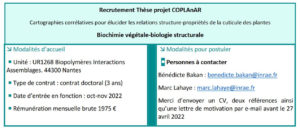Thesis recruitment COPLAnAR project – Correlative mapping to elucidate structure-property relationships in plant cuticles Plant biochemistry-structural biology

Missions
The work is part of the research project “COPLAnAR: correlative mapping to elucidate the structure-property relationships of the plant cuticle”. The project, funded by the National Research Agency (ANR) and the Pays de la Loire Region, will be carried out in close collaboration with INRAE Bordeaux (UMR BPF), the University of Orsay (ICP) and the Cornell University (USA). Plant cutics are complex hydrophobic structures of lipid (cutin, a polyester of hydroxy fatty acids) and polysaccharide (pectin, hemicellulose, cellulose) polymers. They are involved in the development of plants and their resistance to environmental stress, and are now a prime target for the selection of plants adapted to climate change. The relationships between the architecture of these polymer assemblies and their functional properties are still lacking and are a major scientific challenge. Using the tomato as a model, the objective of the thesis is to decipher the macromolecular architecture of the cuticle (natural plant composite) through a correlative approach involving biochemical approaches, spectral analyses, and measurements of mechanical properties at different scales.
This thesis work will benefit from original fruit lines affected in the structure of lipid polymers and
polysaccharides and generated by the project partners (INRAE Bordeaux, Univ. Cornell). This work will be carried out at the BIA laboratory in a multidisciplinary work collective (ELIPS, PVPP, BIBS teams) experiments will be carried out on the APEX platform (Nantes), and occasionally at the ICP (Orsay).
SKILLS
The thesis project is multidisciplinary. The candidate will have a Master 2 or equivalent, and will have skills in
- Plant biology and biochemistry and analytical chemistry (GC-MS, LC-MS, FT-IR, RAMAN, enzyme biochemistry, MS)
- Foundation in chemometrics and statistical analyzes (R).
- Ability to organize, synthesize and communicate scientifically in English.
- Rigor, autonomy, scientific curiosity and ability to work in a team and interact with cultural teams
different scientists (multidisciplinary)
Laboratory references on the subject.
Bakan, B. and Marion D. “Assembly of the Cutin Polyester: From Cells to Extracellular Cell Walls.” Plants 6, no. 4 (2017): 57. http://www.mdpi.com/2223-
7747/6/4/57.
Lahaye, Marc, Wafae Tabi, Lucie Le Bot, Mickael Delaire, Mathilde Orsel, José Antonio Campoy, José Quero Garcia, and Sophie Le Gall. “Comparison of Cell
Wall Chemical Evolution During the Development of Fruits of Two Contrasting Quality from Two Members of the Rosaceae Family: Apple and Sweet
Cherry." Plant Physiology and Biochemistry 168 (2021/11/01/2021): 93-104. https://doi.org/https://doi.org/10.1016/j.plaphy.2021.10.002.
https://www.sciencedirect.com/science/article/pii/S098194282100512X.
Philippe, G., C. Gaillard, J. Petit, N. Geneix, M. Dalgalarrondo, C. Bres, J. P. Mauxion, et al. "Ester Cross-Link Profiling of the Cutin Polymer of Wild-Type and
Cutin Synthase Tomato Mutants Highlights Different Mechanisms of Polymerization." [In eng]. Plant Physiology 170, no. 2 (Feb 2016): 807-20.
https://doi.org/10.1104/pp.15.01620. http://www.ncbi.nlm.nih.gov/pubmed/26676255.
Philippe, G., N. Geneix, J. Petit, F. Guillon, C. Sandt, C. Rothan, M. Lahaye, D. Marion, and B. Bakan. "Assembly of Tomato Fruit Cuticles: A Cross-Talk between
the Cutin Polyester and Cell Wall Polysaccharides." New Phytol 226, no. 3 (May 2020): 809-22. https://doi.org/10.1111/nph.16402.
https://www.ncbi.nlm.nih.gov/pubmed/31883116.
Reynoud, N., J. Petit, C. Bres, M. Lahaye, C. Rothan, D. Marion, and B. Bakan. "The Complex Architecture of Plant Cuticles and Its Relation to Multiple Biological
Functions." Front Plant Sci 12 (2021): 782773. https://doi.org/https://doi.org/10.3389/fpls.2021.782773.
https://www.ncbi.nlm.nih.gov/pubmed/34956280.

